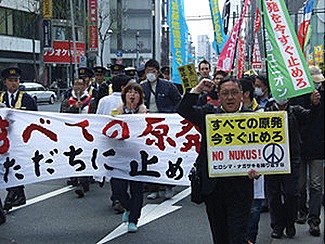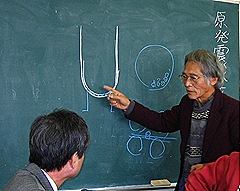“It’s an absolute lie that nuclear power plants have been built with cutting-edge engineering,” said Mr. Yoichi Kikuchi, the ex-engineer engaged in the construction of the Reactor 6 of Fukushima First Nuclear Power Plant, in an interview with a journalist of the Chunichi. This is the shocking article about the nuclear plant on the newspaper on 15th. I’ve translated it into English as below:
“I don’t know when and where severe accidents occur, but it’s inevitable, and it’s happened to be in Fukushima. That’s all.” Mr. Kikuchi is seeing the accident of Fukushima First Nuclear Power Plant, which has been out of control by loss of power, coolly at his home in Kushima, Miyazaki Prefecture.
He was born in Kamaishi, Iwate Prefecture, which has been destroyed by the tsunami caused by the Great Northeastern Japan Earthquake this time. After graduating the university, he had done consulting work on construction, but got a job with U.S’s General Electric Company (GE) in 1973 because an acquaintance of his asked him, saying “Give assistance to the peaceful uses of atomic energy.”
Mr. Kikuchi has engaged in building the Reactor 6 of Fukushima First Nuclear Power Plant and Japan Atomic Power Company’s Tokai Second Nuclear Power Plant (Tokai-mura in Ibaraki Prefecture) for about seven years until 1980 when he left the company. Fukushima First uses boiling light-water reactors, which was designed by GE but was built by Japan’s builders. He was the administrator of schedule for the construction and had to complete the buildings within the assignment timetable. It took four years for building a nuclear reactor at that time. He was involved in Tokai Power Plant for 4 years and Fukushima for the last one year. “The atomic technology wasn’t established at all at that time. Everything was reckless and wild.”
Unskilled Workers
According to him, changing plats always happened. “We couldn’t go ahead with planned action at the actual construction. We had to rewrite plats many times.” They sometimes juggled the construction with brute-force construction technique. They spent 6 billion yen for the Reactor 6.
There were many sloppy works at the construction site as well. Most workers urinated in the bottom of the nuclear containment vessel of the Reactor 6 when they were building it. It was troublesome for them to go up to the toilet at the top of the vessel. There were quite number of unskilled workers, and some of them worked muttering, “I have no confidence.” “All of them weren’t workmanlike. Many of them just wanted to go home for the day.”
Most of workers didn’t report their mistakes to builders or Tokyo Electric Power Company. If they had talked to them the truth, they would have lost their jobs next time. Naturally, flaws which might cause severe accidents lie neglected. Mr. Kikuchi has found a serious flaw at the Reactor 6. It was a pipe where a stopcock for investigation was bulging 1.8 cm inside. If there were bulging parts inside, the circulation couldn’t go smoothly and fractures might happen suddenly. He reported to the quality control manager, but the problem became “unqualified”. “No one had noticed until I found it out. There were many things we shouldn’t have done nonchalantly.”
Mr. Kikuchi has engaged in the repair work on Fukushima First Nuclear Power Plant before. According to him, there were always risks of exposure to radiation at the site.
Workers cleaned the contaminated vessel after the spent nuclear fuel rod was removed from the nuclear reactor pressure vessel. They went into it by an iron gondola and washed inside with a hose. The diameter of the pressure vessel is about six meters. The gondola was swaying by the water pressure. Mr. Kikuchi has been to the top of the vessel. “I was scared. I bet the workers felt more scared. People don’t know about the reality of the situation on exposure to radiation.” The repair work was sealing a crack at the joint between the pressure vessel and the pipe. Pipes shake while the reactor is working. “There’s often a crack without noticing. It may be natural because of the sloppy works.”
Mr. Kikuchi has engaged in constructions of oil factories in Middle East after leaving GE, but nuclear power plants stuff has been burned into his brain. “I had a nightmare about an accident of nuclear power plants almost every night. In the dream, the pipe of the pressure vessel breaks suddenly and…” He has begun joining in anti-nuke movements since the accident occurred at Fukushima Second Nuclear Power Plant in 1989. He couldn’t help appealing the risk of nuclear power generation. “Neither the government nor the electric power companies understand the reality situation of the nuclear power plants.”
Concerned about Hamaoka
The containment vessels of the Reactors 1 to 5 at Fukushima First Nuclear Power Plant are called Mark I and have flask-like forms, the Reactor 6, in which Mr. Kikuchi has been involved, is called Mark II and has a bell shape. Fukushima Second’s Reactor 1 to 4 and Kasiwazaki-Kariwa’s 1 to 7 are Mark II. It’s revealed that Mark I has more load than expected if a severe accident happens because it is small in capacity. Mark II is 1.6 times in capacity. “Mark II is much safer than Mark I, but they have built five Mark I vessels one after another. It was a big mistake.”
So, are there no problems in Mark II? “Designers of GE concern about severe accidents sufficiently, though Japan’s government and the electric power companies just say, ’Nuclear Power Plants are safe.’ However, the measure for safety of Mark II is not enough because no one could save it once the reactor became out of control. It’s wrong to think to try to save it. If it’s possible for the purpose of calculation, we are behind in construction technology.”
Mr. Kikuchi had lived in Shizuoka for a year in 2002 for appealing for stopping Hamaoka Nuclear Power Plant, which would be damaged by Tokai Earthquake in the near future. He is now living in Kushima to block a project of construction of a nuclear power plant of Kyushu Electric Power Company. He is worried about Hamaoka Nuclear Power Plant. “If an inland earthquake hit there, Hamaoka Nuclear Power Plant couldn’t stand. Its damage could be more catastrophic than Fukushima.”


